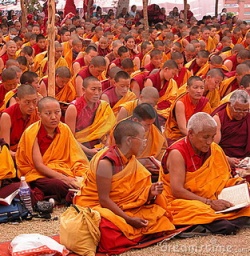Difference between revisions of "Vimuttimagga"
| Line 3: | Line 3: | ||
The Vimuttimagga, [[Path of Freedom]], is a manual of [[Spiritual]] practice for [[Monks]] and [[Nuns]] composed in either South [[India]] or [[Sri Lanka]] by Upatissa [[Thera]]. It may date from between the 1st and 4th centuries CE. | The Vimuttimagga, [[Path of Freedom]], is a manual of [[Spiritual]] practice for [[Monks]] and [[Nuns]] composed in either South [[India]] or [[Sri Lanka]] by Upatissa [[Thera]]. It may date from between the 1st and 4th centuries CE. | ||
| − | It seems [[Buddhaghosa]] had this work available to him when he wrote his [[Visuddhimagga]] and may even have used it as his model. The two works are similar in content and structure except that the Vimuttimagga is more practical, particularly on the subject of [[Meditation]], and shows no influence of [[ | + | It seems [[Buddhaghosa]] had this work available to him when he wrote his [[Visuddhimagga]] and may even have used it as his model. The two works are similar in content and structure except that the Vimuttimagga is more practical, particularly on the subject of [[Meditation]], and shows no influence of [[Abhidhamma]]. The Vimuttimagga disappeared in [[India]] and [[Sri Lanka]] but was preserved in a Chinese translation. |
The Vimuttimagga ("Path of Freedom") is a Theravada Buddhist practice manual, traditionally attributed to the Arahant Upatissa (c. 1st or 2nd century ). It was translated into Chinese in the sixth century as the 'Cie-to-tdo-lun' (解脫道論) by Sanghapala. The original text (Possibly Pali or Buddhist Hybrid Sanskrit) is no longer extant, but the work has survived in Chinese. The book was probably written in India and then later brought to Sri Lanka. The Vimuttimagga recommends various meditation practices such as Anapanasati, Kasina meditation and Buddhanussati - recollection of the virtues of the Buddha. The Vimuttimagga bears a striking similarity to the Visuddhimagga by Buddhagosa, and it is highly probable that it had an influence on Buddhagosa. While the Visuddhimagga is much longer work, both texts only differ on minor points. For example, Upatissa gives four categories of Śīla while Buddhagosa gives five. Upatissa gives four ways of cultivating Anapanasati, while Buddhagosa gives eight. | The Vimuttimagga ("Path of Freedom") is a Theravada Buddhist practice manual, traditionally attributed to the Arahant Upatissa (c. 1st or 2nd century ). It was translated into Chinese in the sixth century as the 'Cie-to-tdo-lun' (解脫道論) by Sanghapala. The original text (Possibly Pali or Buddhist Hybrid Sanskrit) is no longer extant, but the work has survived in Chinese. The book was probably written in India and then later brought to Sri Lanka. The Vimuttimagga recommends various meditation practices such as Anapanasati, Kasina meditation and Buddhanussati - recollection of the virtues of the Buddha. The Vimuttimagga bears a striking similarity to the Visuddhimagga by Buddhagosa, and it is highly probable that it had an influence on Buddhagosa. While the Visuddhimagga is much longer work, both texts only differ on minor points. For example, Upatissa gives four categories of Śīla while Buddhagosa gives five. Upatissa gives four ways of cultivating Anapanasati, while Buddhagosa gives eight. | ||
Revision as of 16:32, 12 June 2013
The Vimuttimagga, Path of Freedom, is a manual of Spiritual practice for Monks and Nuns composed in either South India or Sri Lanka by Upatissa Thera. It may date from between the 1st and 4th centuries CE.
It seems Buddhaghosa had this work available to him when he wrote his Visuddhimagga and may even have used it as his model. The two works are similar in content and structure except that the Vimuttimagga is more practical, particularly on the subject of Meditation, and shows no influence of Abhidhamma. The Vimuttimagga disappeared in India and Sri Lanka but was preserved in a Chinese translation.
The Vimuttimagga ("Path of Freedom") is a Theravada Buddhist practice manual, traditionally attributed to the Arahant Upatissa (c. 1st or 2nd century ). It was translated into Chinese in the sixth century as the 'Cie-to-tdo-lun' (解脫道論) by Sanghapala. The original text (Possibly Pali or Buddhist Hybrid Sanskrit) is no longer extant, but the work has survived in Chinese. The book was probably written in India and then later brought to Sri Lanka. The Vimuttimagga recommends various meditation practices such as Anapanasati, Kasina meditation and Buddhanussati - recollection of the virtues of the Buddha. The Vimuttimagga bears a striking similarity to the Visuddhimagga by Buddhagosa, and it is highly probable that it had an influence on Buddhagosa. While the Visuddhimagga is much longer work, both texts only differ on minor points. For example, Upatissa gives four categories of Śīla while Buddhagosa gives five. Upatissa gives four ways of cultivating Anapanasati, while Buddhagosa gives eight.
